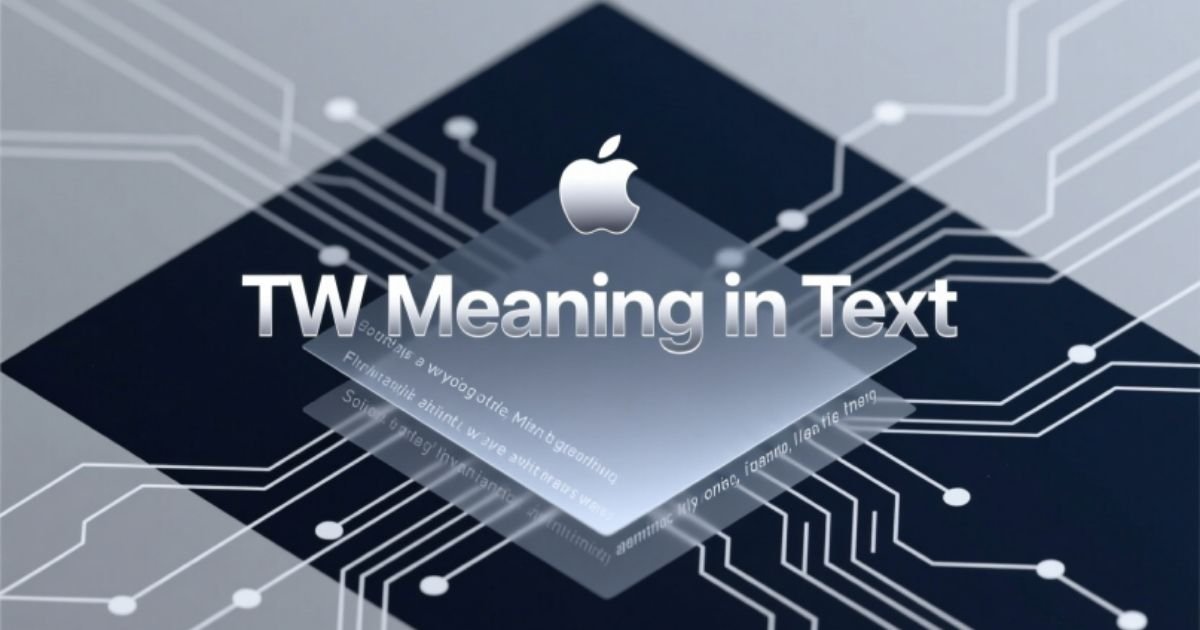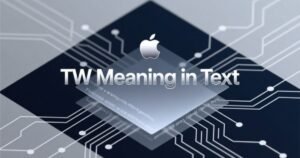Ever got a message with “TW” and stopped dead in your tracks wondering what it means?
You’re scrolling through social media, reading a post, and boom, “TW” pops up.
Your brain freezes.
Is it a warning? A joke? Something you should know?
Here’s the thing: TW meaning in text changes based on where you see it and who’s sending it.
Sometimes it’s serious. Sometimes it’s casual. Sometimes it’s just about next week’s plans.
This guide breaks down everything you need to know about what does TW stand for, when people use it, and how to respond without looking confused.
Let’s jump in.
Meaning & Definition
TW mainly stands for “Trigger Warning” in online communication terms.
A trigger warning is a heads-up that tells you the content ahead might be upsetting or hard to read.
Think of it like a movie rating, but for text messages and posts.
People use TW before sharing topics like violence, abuse, mental health struggles, or anything that could bring up emotional trigger notice for someone.
The purpose of trigger warnings is simple: give people a choice.
They can decide whether they’re ready to read something heavy or skip it for now.
In mental health awareness terms, this tiny abbreviation does big work.
It shows respect and creates safe communication practices in digital spaces.
But here’s where it gets interesting, TW doesn’t always mean trigger warning.
Sometimes it means “This Week” in work chats or casual texts.
Context is everything when you’re trying to interpret TW.
Background & Origin
The trigger warning explanation goes back to online forums and mental health communities in the early 2000s.
Tumblr slang history played a huge role in making TW popular.
Users on Tumblr started adding warnings before posting about trauma, mental illness, or distressing topics.
The goal? Protect fellow users who might be dealing with similar struggles.
From there, TW spread like wildfire across Reddit abbreviation use, Twitter, Instagram, and other platforms.
By 2010, it became standard internet language guide vocabulary.
Colleges and online communities adopted it as part of social media safety etiquette.
Even TikTok caption acronyms now include TW regularly.
The language evolution in social media turned this two-letter combo into a universal symbol of empathy.
It’s proof that modern internet acronyms can actually make spaces kinder.
Today, millions use it daily without thinking twice.
Read More: DTF Meaning in Text: What It Really Means and How to Use It Online
Usage in Different Contexts
TW used in conversation shifts meaning depending on the situation.
In emotional discussions, TW acts as a guard rail.
Someone might write: “TW: depression. Today was really rough for me.”
That’s the sensitive content alert version.
In workplace acronyms, TW often means “This Week.”
Your boss texts: “Can we meet TW?” They’re asking about scheduling, not warning you about anything.
In dating apps, you might see TW in someone’s bio: “TW: I talk about mental health openly.”
That’s the TW used in dating apps style, setting expectations upfront.
College students use it in group chats: “TW for the reading assignment, it covers war trauma.”
Gamers use it differently: “TW: spoilers ahead for the new game.”
The contextual meaning of TW requires you to read the room.
Look at who’s talking, what platform you’re on, and the topic at hand.
One setting needs serious respect. The other just needs a calendar.
Meanings Across Platforms
Instagram trigger warning posts lean heavily toward mental health content.
Users add TW before sharing personal stories about eating disorders, self-harm, or anxiety.
The TW meaning for Gen Z on Instagram is all about creating safer feeds.
On Twitter (now X), TW often appears in threads discussing heavy news or political violence.
People use it before sharing articles about traumatic events.
Reddit communities have specific rules about when to include TW in post titles.
Subreddits focused on support or recovery require it for certain topics.
TikTok creators flash “TW” on screen before videos dealing with mental health posts or sensitive subjects.
The understanding online abbreviations game changes per platform, though.
LinkedIn users rarely see trigger warnings, instead, TW means “this week” in professional chat shorthand.
Slack and Microsoft Teams follow the same pattern for workplace communication.
Discord servers mix both uses depending on the channel topic.
Gaming channels? Probably talking about this week’s tournament.
Mental health support channels? Definitely using it as a warning.
Other Fields
Outside social media, TW pops up in surprising places.
Medical and therapy settings use trigger warning terminology in patient resources.
Therapists might label worksheets or articles with TW before trauma-related material.
Educational institutions include it in syllabi.
Professors write “TW: graphic violence” before assigning certain books or films.
Podcasts and YouTube videos flash TW in descriptions.
True crime shows especially use it before episodes covering disturbing cases.
News websites started adding content warnings (CW) and trigger warnings to articles.
It’s become part of ethical journalism in digital communication.
Corporate training modules sometimes include TW before diversity and inclusion content that discusses discrimination.
Even book publishers now print trigger warnings on back covers or first pages.
The trending internet terms world has crossed into traditional media.
Common Misconceptions & Mistakes
Biggest mistake? Thinking TW and CW mean the same thing.
They’re cousins, not twins.
Difference between TW and CW: Content Warning (CW) is broader and less personal.
TW focuses on trauma triggers specifically.
CW might warn about spoilers, strong language, or graphic images, stuff that’s uncomfortable but not necessarily triggering.
Another mistake: using TW for everything.
If you warn about every little thing, people stop taking warnings seriously.
Save it for genuinely sensitive content.
Some folks think TW is just “Gen Z being soft.”
Wrong take.
It’s actually about emotional impact of TW and giving people autonomy over their mental health.
People also confuse what TW implies in text across contexts.
Seeing “TW” in a work email about scheduling doesn’t mean danger ahead, it means “this week.”
Not recognizing TW cues properly leads to awkward misunderstandings.
Read the context before you react.
Similar Terms & Alternatives
CW (Content Warning) is the closest cousin to TW.
Use CW when the content might be uncomfortable but isn’t specifically about trauma.
TW vs CW difference boils down to intensity and focus.
CN (Content Note) is gentler and informational rather than warning-based.
Some prefer it because “warning” sounds dramatic.
Spoiler Alert serves a similar function for entertainment content.
It’s the fun cousin of TW.
NSFW (Not Safe For Work) warns about sexual or inappropriate content.
Different vibe, same protective energy.
TW vs FYI comparison: FYI just means “for your information”, no warning implied.
Heads Up works as a casual alternative to TW in less serious situations.
“Heads up: this movie gets intense” feels friendlier than “TW: violence.”
Pick the term that matches your audience and platform.
How to Respond to “TW”
How to reply to TW depends on whether you’re the reader or content creator.
If you see TW and you’re comfortable, just keep reading.
No response needed.
If you’re not in the right headspace, thank the person for the warning and skip the content.
Simple: “Thanks for the heads up, I’ll catch this later.”
When someone shares something with TW in a dating app conversation, respect their openness.
Reply with: “I appreciate you sharing that with me.”
In online empathy in communication, small acknowledgments matter.
If you’re posting content that needs TW, be specific.
Don’t just write “TW.”
Say “TW: eating disorder discussion” or “TW: graphic medical description.”
Best response to TW is always respect and understanding.
Never mock someone for adding a warning or needing one.
That’s just basic TW etiquette and respect.
Differences From Similar Words
Let’s clear up confusion between similar texting abbreviations list terms.
TW vs CW: TW is for trauma-specific content. CW is for general discomfort.
TW vs Spoiler Warning: Both warn you, but TW protects mental health while spoiler alerts protect your viewing experience.
TW vs NSFW: NSFW warns about sexual/inappropriate work content. TW warns about emotional triggers.
TW (Trigger Warning) vs TW (This Week): Same letters, totally different meanings.
One lives in mental health conversations. The other lives in calendars and schedules.
How TW improves communication compared to just dropping heavy content: it shows you care about your audience’s wellbeing.
The importance of TW online grows as we share more personal stories publicly.
Understanding these differences helps you decode online chat meanings faster.
Relevance in Online Conversations & Dating Apps
TW in social interaction has become a trust-building tool.
When someone uses TW in their dating profile, they’re setting boundaries early.
It signals emotional intelligence and self-awareness.
Understanding TW abbreviation on dating apps helps you know what to expect from conversations.
Someone writing “TW: I discuss mental health openly” isn’t trying to scare you off.
They’re being honest about their communication style.
In virtual communication language, this transparency matters.
Online friendships often dive deep fast, TW helps navigate those waters safely.
Group chats use it to maintain safe spaces for all members.
The cultural relevance of TW extends to how we build communities online.
It’s part of trending internet terms that actually serve a purpose beyond being trendy.
TW sensitivity meaning in relationships (online or offline) shows you’re thinking about others’ experiences, not just your own.
Popularity & Trends Over Time
TW usage exploded around 2013-2015 when Tumblr was at its peak.
Google Trends shows steady growth in searches for “what does TW mean” since 2010.
Mental health awareness movements pushed TW into mainstream conversation.
By 2020, COVID-19 pandemic discussions made content warnings more common everywhere.
News outlets started using them regularly for distressing coverage.
TikTok adoption in 2019-2021 introduced TW to younger audiences who made it standard practice.
The real-world examples of TW usage multiplied across platforms.
Search volume for “TW meaning in text” peaks during major news events when sensitive content floods social media.
Modern internet acronyms research shows TW remains one of the most-used protective abbreviations online.
It’s not fading, it’s evolving and spreading to new spaces.
FAQ’s
What does TW mean in texting?
TW means “Trigger Warning” before sensitive content or “This Week” when discussing schedules, depending on conversation context and platform usage.
How do you use TW in a sentence?
“TW: anxiety discussion ahead” warns readers about mental health content, while “Let’s schedule our meeting TW” means this week’s calendar.
Is TW the same as CW?
No. TW warns about trauma-specific triggers affecting mental health, while CW covers broader uncomfortable content like spoilers or graphic images.
Why do people use TW online?
People use TW to respect others’ mental health, giving readers choice to engage with heavy content when they’re emotionally ready.
Can TW mean something else in work emails?
Yes. In professional settings, TW typically means “This Week” for scheduling purposes, not trigger warning like in social media contexts.
Conclusion
Grasping the meaning of TW is vital in modern digital communication. Whether it stands for Trigger Warning on social media or shorthand like This Week or Teamwork in professional messages, this flexible abbreviation helps people communicate clearly and respectfully.
Understanding the context lets you interpret messages accurately and respond the right way, whether you’re texting friends, posting online, or chatting at work.
So, the next time you spot TW, you’ll know exactly what it means and how to reply naturally, keeping your online conversations smoother and more thoughtful.

James Smith is the creative force behind Celebrity Meaning, bringing fans closer to their favorite stars by revealing the hidden meanings behind celebrity names. With a flair for fun facts and trending insights, James Smith keeps the site fresh, engaging, and full of star-powered stories!











